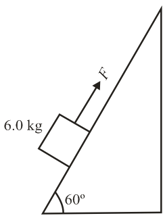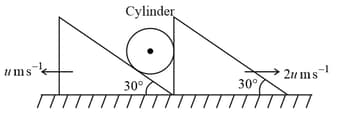A block of mass is placed on a smooth wedge of inclination The whole system is accelerated horizontally so that the block does not slip on the wedge. The force exerted by the wedge on the block ( is acceleration due to gravity) will be
Important Questions on Newton's Laws of Motion
Two inclined planes are placed as shown in figure.
A block is projected from the Point of inclined plane along its surface with a velocity just sufficient to carry it to the top Point at a height . After reaching the Point the block slides down on inclined plane . Time it takes to reach to the point from point is . The value of t is _____ (use )

A solid sphere of mass and radius rolls without slipping on a fixed inclined plane with an angle of inclination from the horizontal. Two forces of magnitude each, parallel to the incline, act on the sphere, both at distance from the center of the sphere, as shown in the figure. The acceleration of the sphere down the plane is . (Take )
If the numerical value has more than two decimal places, truncate/round-off the value to TWO decimal places.
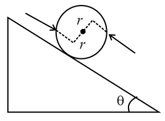

Two blocks each of mass M are resting on a frictionless inclined planes as shown in fig. then :

The coefficient of friction between the block of mass and block of mass is There is no friction between block and the inclined plane. If the system of blocks and are released from rest and there is no slipping between and then
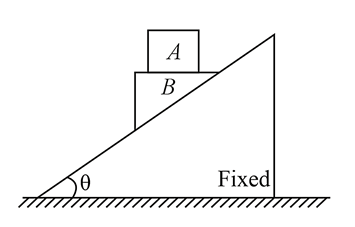
A block of mass lies on the wedge of mass , which lies on the fixed horizontal surface. The wedge is free to move on the horizontal surface. A horizontal force of magnitude is applied on the block as shown, neglecting friction at all surfaces, the value of force such that block has no relative motion with respect to the wedge will be (Where is the acceleration due to gravity)
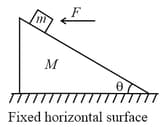
The block of mass Is in equilibrium relative to the smooth wedge of mass Which is pushed by a horizontal force Find
(a) Pseudo force acting on m
(b) As viewed by the observer sitting on the wedge. Will these pseudo forces
(c) equal and opposite, action–reaction pairs? Explain.
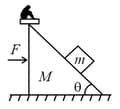
Represent the union of two sets by Venn diagram for each of the following.
is a prime number between and
is an odd number between and
In the arrangement shown mass of the block and are and, respectively. Surface between and floor is smooth. The block is connected to block by means of a pulley. If the whole system is released then the minimum value of the mass of the block so that the block remains stationary with respect to is: (Coefficient of friction between and is and pulley is ideal)
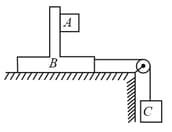
A block of mass is placed on a smooth inclined wedge of inclination as shown in the figure. The wedge is given an acceleration towards the right. The relation between and for the block to remain stationary on the wedge is,
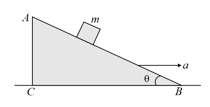
A block of mass lies on wedge of mass which lies on fixed horizontal surface. The wedge is free to move on the horizontal surface. A horizontal force of magnitude is applied on block as shown, neglecting friction at all surfaces, the value of force such that block has no relative motion w.r.t. wedge will be : (where is acceleration due to gravity)
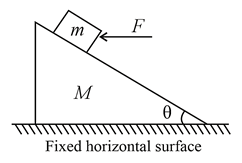
Block of mass and block of mass are placed on a fixed triangular wedge by means of a massless, inextensible string and a frictionless pulley as shown in figure. The wedge is inclined at to the horizontal on both the sides. The coefficient of friction between the block and the wedge is 2/3 and that between the block and the wedge is 1/3 and both the blocks and are released from rest, the acceleration of will be
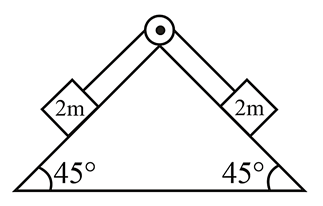
Two blocks of masses and are connected by a light string passing over a smooth pulley and rest on two inclined planes as shown in Fig. . In which direction would the system move? Find the acceleration of the blocks and the tension in the string.


The given figure shows a block on a ramp with a coefficient of static friction of . A force is applied up the ramp. What magnitude of that force puts the block on the verge of sliding down the ramp?
